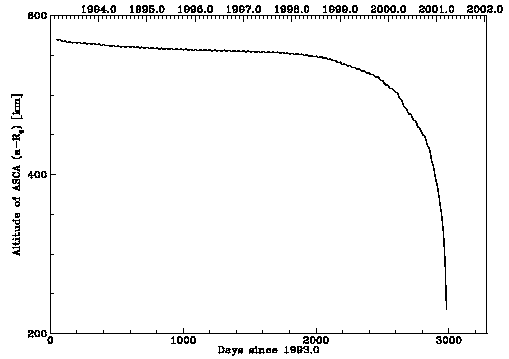The Decay of ASCA's Orbit
ASCA was launched into a roughly circular orbit with an initial altitude of 570 km, and an orbital period of 96.1 minutes.There were no consumables on-board ASCA. Thus, the lifetime of the satellite was determined by the inevitable aging of the components and by the decay of the satellite orbit. The former took the form of slow degradation in the performance of, for example, the on-board batteries, or a sudden breakdown of components, such as gyroscopes. Although ASCA experienced its share of these (for example, two of the five gyroscopes showed erratic behaviors), the satellite remained healthy and functional overall. The end of the ASCA mission was the result of the decay of its orbit, and a large geomagnetic storm.

The plot above shows the altitude of the ASCA orbit since launch. ASCA did not travel in a complete vacuum at the altitude of 550 km. There was enough (though very tenuous) atmosphere such that the friction dragged down satellites gradually. As ASCA dropped to lower altitude, it encountered increasingly denser parts of the atmosphere; moreover, the density of the upper atmosphere increased towards the end of the mission due to increased solar activity. Thus, the rate of orbital decay also increased.
A large solar flare erupted on July 14, 2000, with an extremely strong solar proton flux. When these charged particle reached the Earth, it triggered a strong geomagnetic storm that lasted for a few days starting on July 15. The geomagnetic storm caused a sudden increase in the density of the atmosphere around ASCA. This acted like a sudden gust of wind on a car crossing a bridge: the attitude control system of ASCA could not keep up with the buffeting of the satellite, and it entered a safe hold mode. The satellite stared spinning slowly, with the solar panels pointed somewhat away from the sun.
Despite heroic effort by the Japanese operations team, they could not regain control of the satellite attitude. If they could slow down the spin, and point the solar panel to the Sun, normal operation could have resumed; however, the battery was far from fully charged, which made it impossible to slow down the spin.
In the mean time, the orbit of ASCA kept decaying. Finally, the satellite re-entered the atmosphere at 05:21 UT on March 2, 2001, ending one of the most successful missions in the history of X-ray astronomy.
This page created by Dr. Koji Mukai (USRA) at the U.S. ASCA Guest Observer Facility.
This file was last modified on Monday, 28-May-2001 17:15:23 EDT
Curator:
HEASARC Guest Observer Facility
If you have any questions concerning ASCA, visit our Feedback form.

